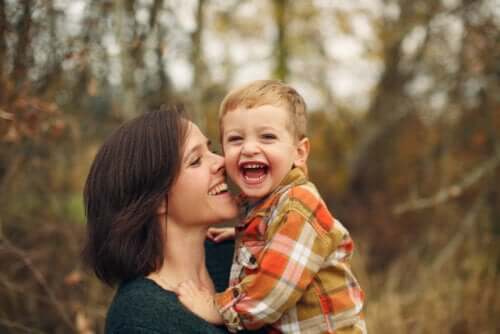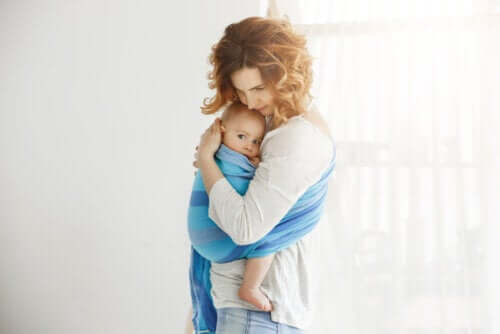How to Nurture Healthy Attachment During Childhood


Written and verified by the psychologist Mara Amor López
A healthy attachment bond is the main reason for security in childhood and something fundamental in our adult lives as well. In fact, our emotional development and correct personality development will depend on it.
Therefore, it’s important to point out the importance of giving our children all the affection and care they need from birth so that they grow up as people with the capacity to give and receive love.
It’s fundamental for our mental health that this attachment exists between human beings. The bond that’s established between mother and child will be decisive for the consolidation of their adult personality.
What’s a healthy attachment bond?
The attachment bond is the affective union established between the mother, or main caregiver, and the child from birth. This bond will become key in the child’s psychological development and the formation of their personality.
This bond doesn’t end when infancy passes; it will be the foundation for future relationships throughout the child’s life. Attachment to the important people in our lives will continue throughout our development, even as adults.
How does the formation of attachment occur?
From the moment a baby is born, they’re receptive to any stimulus coming from their attachment figure, generally the mother. During the first year of life is when the child establishes this bond with the person they have more contact with, and it’s when the fear of strangers arises.

Healthy attachment provides security and protection for the child in threatening situations. When the attachment bond is well established, the child explores the world calmly, knowing that their attachment figure will be there to protect them.
When the bond isn’t properly established, fears and insecurities arise, and this will affect the way children behave and relate to others.
“Attachment is an affective relationship that is established from birth to death and, therefore, endures throughout life.”
– John Bowlby –
Types of attachment proposed by Bowlby
- Secure attachment. This is determined by unconditionality. The child knows that their mother or primary caregiver won’t fail them, no matter what. People with secure attachment during childhood tend to relate in a healthy way as adults.
- Anxious or ambivalent attachment. In this type of attachment, the child doesn’t trust and feels insecure regarding their caregivers. They feel that they may be abandoned, and this generates feelings of fear and anxiety. Adults with this type of attachment would be those who don’t have emotional independence.
- Avoidant attachment. Children with this type of attachment assume that they can’t depend on their caregivers, and this causes them suffering. They don’t cry when separated from their attachment figure and avoid any close contact. Adults who in their childhood had the avoidant attachment type will have difficulties in relating to others and will have feelings of rejection of intimacy with others.
- Disorganized attachment. This type of attachment is a mixture of avoidant and anxious attachment. Here, the child presents contradictory and inadequate behaviors. This would be totally contrary to secure attachment, as it would occur when there’s been an early abandonment and the child distrusts their caregivers. As adults, they’re people with high frustration and anger; they feel they’re not loved and reject relationships, although deep down these are their greatest desire.

What can be done to nurture a healthy attachment bond?
- Maintain bonding from the moment of birth.
- Breastfeed whenever possible.
- Sleep close to the baby so that they notice your closeness.
- Maintain body contact with the child. They need to be attached to their mother in any situation of their day-to-day life.
- Rely on their crying as an early expression of language. If they cry, something’s wrong, and it’s important to tend to their needs. Don’t ignore them when they cry. If they cry, it’s because they’re uncomfortable or upset.
- When it comes to instilling habits in children, we must be flexible. Don’t force your baby to eat or sleep, for example.
- Maintain a balance. You should be neither too strict nor too permissive; the right thing to do is aim for a middle ground.
- Both mom and dad take care of the baby. Both should build a safe and trusting environment with the little one.
You’ve already seen how important it is to form a secure and healthy attachment bond. Because this is what will determine their future personality, relationship development and, ultimately, their mental health. It’s important that we strive to nurture this bond so that our children today will be healthy adults tomorrow.
All cited sources were thoroughly reviewed by our team to ensure their quality, reliability, currency, and validity. The bibliography of this article was considered reliable and of academic or scientific accuracy.
- Vega Franco, L. (2010).Importancia de fomentar el vínculo de apego en la infancia. Revista mexicana de pediatria, 77 (3); 103-104.
- Garrido-Rojas,L. (2006). Apego, emoción y regulación emocional.Implicaciones para la salud.Revista Latinoamericana de Psicología, 38 (3); 493-507
This text is provided for informational purposes only and does not replace consultation with a professional. If in doubt, consult your specialist.








